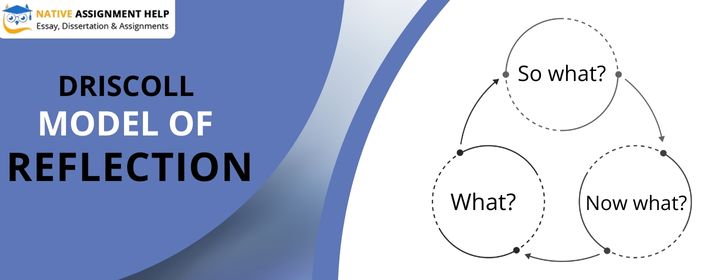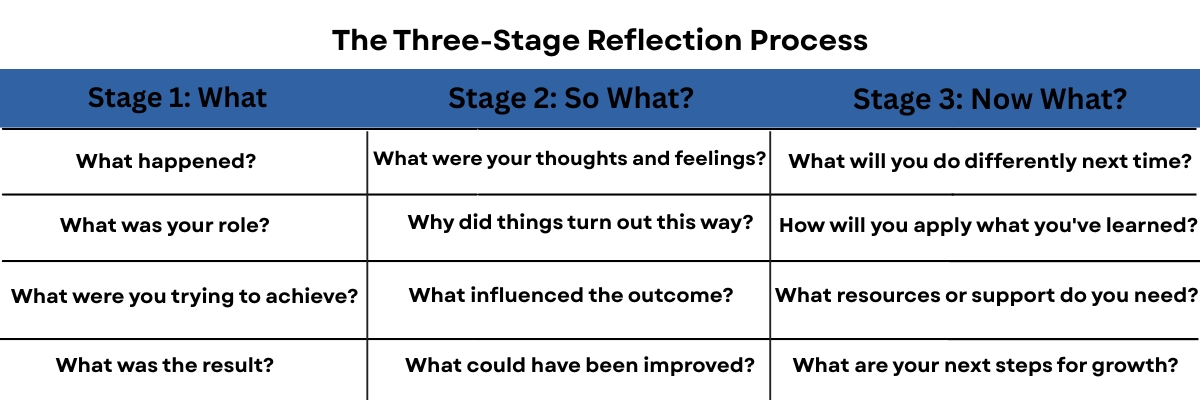
Driscoll Model Of Reflection: A Comprehensive Guide For UK Students
The Driscoll Model of Reflection is one of the most commonly used reflective models for students and professionals alike. Its applications are varied, yet its uses are simple and efficient. If you have been looking to learn about this model or its applications, then this guide will prove useful. Take a look and you will have your doubts resolved for sure.
What Is The Driscoll Model Of Reflection?
Driscoll, back in 1994, proposed a simple reflective model for the introspection analysis. He named it the Driscoll mode of reflection, which is based on the three simple yet important questions: What? So What? Now What?. These questions, originally proposed by Terry Borton back in 1970, became the foundation of the Driscoll Model of Reflection.

Now, whether it be students or professionals, all find the applications of this model in their everyday lives. Students use this model for reflective writing and introspection for their work. Similarly, professionals in nursing, education, and other such fields use it to reflect on their experiences. It is one of the most popular and simple reflective models that helps with the critical analysis, in-depth understanding, and learning from experiences. It is based on a simple correlation between the three aforementioned questions.
Stage 1: What
The first stage of the Driscoll Model of Reflection defines the most integral and basic part of introspection. It starts with understanding the issue itself and answering a few basic questions related to it, such as:
- What was the problem?
- What was my role in it?
- What was I trying to achieve?
- What was the outcome?
- What other factors were involved in it?
- What was the context of the situation?
Each question is from the perspective of the person doing the introspection. The results, once collected, should be noted down before moving on to the next step. Suppose a nursing professional faced communication issues during a patient check-up. They would note down about their experience, what they said, where the patient had trouble understanding, and such.
Stage 2: So What?
Once the information regarding the issue has been collected, it's time to start analysing it. In this stage, the reflector has to answer the questions from stage 1 and recount their experiences, feelings, and learnings from it. Some of the common thoughts during this stage would be
- What are my thoughts on the problem?
- What could I have done differently?
- Why didn’t I achieve the goal?
- How could the outcome have been changed?
- How to take note of the other factors?
- What were my feelings/thoughts during the situation?
Continuing on the aforementioned example, this stage would be about analysing the situation. They would think about their actions or their tone that could have resulted in confusion. Would there have been different outcomes if the professional had chosen other options? These questions are mainly about self-introspection, understanding the reasons, and thinking about what they could have done differently.
Stage 3: Now What?
Any introspection or reflection is useless without recognising changes to the method. This is exactly what the Driscoll Model of Reflection demands in its last stage. From stage 1, you recognised the problems, and reflection in stage 2 brought you to the reasons. So now the interospector has to plan on what could be done differently. Don’t think of generic answers like “I’ll do better next time”. Recognise the issues accurately and choose better options to prevent the same issue again.
Questions to consider next
- What will you do differently next time?
- How will you apply what you have learned?
- What resources or support do you need?
- What areas require further development?
Since the goal of the reflection is to improve and avoid similar issues again, it's obvious to find actual solutions. In the aforementioned example, the nursing professional would need to improve their communication skills. They would have to note down easy-to-understand terminology for the patients. Doing so would help them avoid similar issues. That is what the Driscoll model of reflection showcases.
A Cross-Disciplinary Perspective On The Driscoll Model Of Reflective
The Driscoll Model of Reflective writing is immensely popular for its wide range of applications. It can be used by students, by professionals, and even by normal folks in their everyday lives. Let's take a look at how different disciplinary students use the model.
Nursing and Healthcare
For those in the nursing and healthcare industry, their challenges would be varied. Some are faced with ethical dilemmas, some have difficulty communicating with their patients ,while some are just worried about proper nursing procedures. The method gives a clear guideline to recognise errors and work on them.
Education and Teaching
In the changing field of education, the teaching techniques are never static. Educators have to understand their learners' needs and make their plans based on that. In such a task Driscoll Model of Reflection plays a significant role. It also helps in the continuous improvement of the teachers themselves.
Business and Management
Evaluation is a key part of business and management courses, and the Driscoll model is great at this very aspect. Whether it be the leadership styles, project outcomes, or team building exercises, each can be evaluated through this model.
STEM Fields (Science, Technology, Engineering, Maths)
Students can use this model to reflect on their lab work, improve their technical problem-solving skills, and group projects. It can be used to improve their documentation and methodological improvement, too.
Discoll Model Of Reflection In Practice: An Example
Let's take an example of the Discoll Model of Reflection in practice to understand each point clearly.
Scenario: A student, Matt, received an essay writing task for a topic he was quite proficient in, but he ended up missing the deadline.
What?
After receiving a project on a topic that Matt was already familiar with, he decided to take it easy and not start it right then. This brought delays to the project's start. Later, when he started working on it he realised the difficulty of the topics in depth research. Even though he rushed to complete it, the project was still not completed on time, and the deadline was missed. After the fiasco, Matt decided to take time and understand the issues of why his procrastination brought such results.
So What?
Matt was anxious about the results, but knew the underlying issue was his delaying working on the project. So he dove deep into thinking about it. He realised that a key reason for the problem was his lack of understanding regarding the topic's depth. He considered it easy, but when it came to actually working on the project, his lack of knowledge and research skills became apparent. He realised how his confidence in the subject became the reason for his problem.
Now What?
After clear analysis Matt recognised the his errors and decided to make proper plans to avoid repeating them. To start off he decided to make proper time management plans for the project and choose to add his deadline as 4 days prior to the given one. He started to use time management techniques and planners for efficient completiong. He noted down his lack of subject knowledge and research skills during the analysis. To resolve this, he decided to give precedence to understanding and researching the topic in his assignment schedule.
Following this method, the Driscoll Model of Reflection can assist students and professionals alike in resolving their challenges. Though the resolution and reflection would vary for each case, the process would remain the same.
Advantages Of The Driscoll Model
The Driscoll Model of Reflection is one of the most commonly used frameworks around the world. There are many advantages to using this model over the other common reflection modes. These include:
- Simplicity: The Three-question methodology of the model is easily understandable even for those new to the framework. This makes it highly suitable for practical use.
- Clarity: The Driscoll Model is based on simple yet clear working methodologies. It provides a straightforward method for students to use the reflection method.
- Flexibility: The Driscoll model can be used in any situation and in various fields. Whether it be a healthcare professional, an educator, or even a STEM student, everyone can find their use.
- Encourages Action: Instead of just recognising the issues and leaving the reflection there, the Driscoll Model encourages action.
- Supports Continuous Learning: The model encourages students to continuously analyse their performance and make constant improvements.
Limitations Of The Driscoll Model
Just like how there are varied advantages to the Driscoll’s Model, there are similarly disadvantages too. Here we have gone through a list of the major limitations for students to take note of:
- Over-Simplicity: What is the biggest advantage of the model is also its biggest disadvantage. Most critics argue that the model is overly simple and hence doesnt give chance for deep critical analysis.
- Surface-Level Reflection: The reflection part of the model is based on the users own learnings and feelings. That is but a surface level reflection as more in-depth reflection requires guidance.
- Not Theory-Rich: The model is inherently centered around its 3-question approach with not much room for further additions. It doesnt require integration with other academic theories, and that is a big disadvantage.
- Lacks Emotional Depth: Most of the other models, especially the Gibbs model, focus on the emotional reflection as a key aspect. Driscoll Model, on the other hand, doesn't give much thought to it.
- Repetition Risk: Since the model is simple, its analysis could be similarly so. Hence, its repetitive use would have a risk of formulaic and repetitive responses. These responses would only be superficial.
Tips For Writing Effective Reflective Pieces
An effective reflective writing requires a model as a framework, but that's not all. If you wish to make a detailed analysis of your work or any situation, then it's necessary to be mindful of a few things. Here we have mentioned such useful tips for a better reflective work.
- Be Honest: Authenticity is the key to a well-crafted reflective piece. No matter what your reasons were or what your thoughts are, always be honest while following the model.
- Stay Focused: Never divert from your goal while writing a reflective piece. Since the goal is to reflect on the experience, it's necessary to choose a specific event to focus on.
- Use the Model: The model itself is a working methodology, so try to define your process in its three steps of “What?’ “So what?” “Now What?”. Choose appropriate work for each step to improve its clarity.
- Incorporate Theory: A limitation of the model is its lack of theory integration, but that could be countered by your own efforts. While writing your self-reflection, try to incorporate academic theories to make more informed decisions.
- Maintain Confidentiality: While it's important to be honest in reflective writing, its equally vital to maintain confidentiality among the work. Avoid using real names in your work.
- Seek Feedback: You can’t notice everything wrong about your work alone. Many times, a different perspective is needed, too. So, seek out your mentors or your friends to get proper feedback on the situation.
- Revise and Improve: Reflection is a skill that improves with practice. So, continuously revise your experiences, even minor daily ones, to make sure your findings are well articulated.
Conclusion
The Driscoll Model of Reflection is a simple yet efficient framework. It is suitable for both students and working professionals in varied fields. Its three-question model, although lacking in depth and theoretical integration, is still one of the best working methodologies for reflective writing. However, that's not to say it won't be difficult. While working on your reflective work, you will require proper details about the topic. However our nursing assignment help service can fulfil that role for you.
And if your work seems stuck, even with the guide at hand, then it's best to seek some aid instead of worrying about it alone. The academic professionals at Assignment Help UK are always available to assist the students with such tasks. If you are concerned about it and need some aid, connect with them and they will resolve it for you.
I am PhD scholar with an education from Cardiff University. I have been evaluated by strict assessment criteria and still managed to get the best grades. If you are also facing similar issues, I assure you I can help you match your professor's demanding expectations




